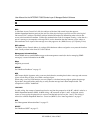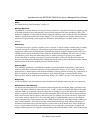
User Manual for the NETGEAR 7300S Series Layer 3 Managed Switch Software
C-20 Glossary
202-10088-01, March 2005
TFTP
See “TLS” on page 20.
TLS
Short for Transport Layer Security, TLS is a protocol that guarantees privacy and data integrity between
client/server applications communicating over the Internet.
The TLS protocol is made up of two layers. The TLS Record Protocol ensures that a connection is private by
using symmetric data encryption and ensures that the connection is reliable. The second TLS layer is the
TLS Handshake Protocol, which allows authentication between the server and client and the negotiation of
an encryption algorithm and cryptographic keys before data is transmitted or received. Based on Netscape’s
SSL 3.0, TLS supercedes and is an extension of SSL. TLS and SSL are not interoperable.
Telnet
A TCP/IP application protocol that provides a virtual terminal service, allowing a user to log into another
computer system and access a device as if the user were connected directly to the device.
Traffic prioritization
Giving time-critical data traffic a higher quality of service over other, non-critical data traffic.
Trivial File Transfer Protocol
TFTP is a simple form of the File Transfer Protocol (FTP). TFTP uses the User Datagram Protocol (UDP, a
direct protocol used to communicate datagrams over a network with little error recovery) and provides no
security features. It is often used by servers to boot diskless workstations, X-terminals, and routers.
Trunking
The process of combing a set of trunks that are traffic-engineered as a unit for the establishment of
connections between switching systems in which all of the communications paths are interchangeable.
U
UTP
Unshielded twisted pair is the cable used by 10BASE-T and 100BASE-Tx Ethernet networks.
V
Virtual Local Area Network
Operating at the Data Link Layer (Layer 2 of the OSI model), the VLAN is a means of parsing a single
network into logical user groups or organizations, as if they physically resided on a dedicated LAN segment
of their own. In reality, this virtually defined community may have individual members peppered across a
large, extended LAN. The VLAN identifier is part of the 802.1Q tag, which is added to an Ethernet frame by


















